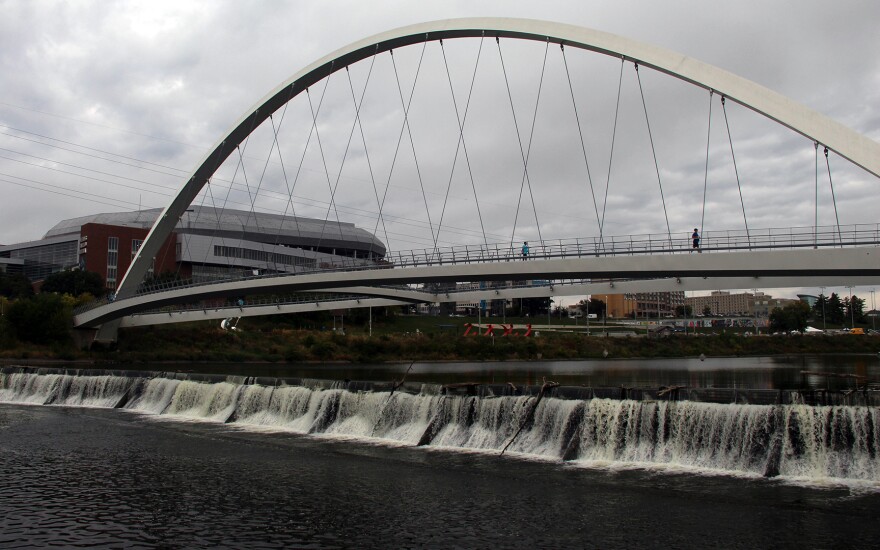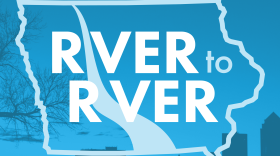EDITOR’S NOTE: Ten years ago Iowa adopted a Nutrient Reduction Strategy — a roadmap to curb the amount of nitrogen and phosphorous contaminating the state’s waterways and contributing to a massive "dead zone" in the Gulf of Mexico. Over the next several weeks, IPR News looks at what has and hasn’t changed in the decade since.
Iowa’s Nutrient Reduction Strategy (NRS) is the centerpiece of the state’s efforts to curb pollution from nitrogen and phosphorus, especially from Iowa farms.
A decade after it was first adopted, farmers and landowners have added millions of acres of cover crops and installed more conservation measures to control nutrients, but the state is still far from reaching its water quality goals.
“We have so much more work to do. We have to recognize we have 24 million acres in the state of Iowa of annual row crop land, and so really we need to be doing something on all those lands to help us reduce nitrogen and phosphorus,” said Matt Helmers, director of the Iowa Nutrient Research Center at Iowa State University.
Iowa adopted a Nutrient Reduction Strategy after a U.S. EPA task force called on states throughout the Mississippi River basin to take action to shrink the Gulf of Mexico hypoxic zone. Also known as the dead zone, the area covers thousands of square miles in the Gulf, where marine life is either dead or gone because nitrogen and phosphorus from the river feed an overgrowth of algae in the ocean.
Iowa’s plan was released in 2013 outlining methods the state can follow in order to cut down its share of the nitrogen and phosphorus load in the Mississippi. The ultimate goal was the same as for the rest of the river basin — reduce nutrient levels by 45%.
Moving toward that goal is important not only for the dead zone, but also locally. Cities like Des Moines battle high nitrogen levels in drinking water, in the form of nitrates. Nutrient pollution also causes toxic algae blooms that close beaches in the summertime.
The NRS presents a sort of road map. It gives a list of practices, like using cover crops or restoring wetlands, and for each one it calculates how much it improves water quality. Much of it relates to agriculture because nonpoint sources, which are unregulated sources of nutrient pollution such as fertilizer runoff from farms, contribute more than 90% of the nitrogen and 80% of the phosphorus entering Iowa waterways.
A snapshot of Iowa water quality
The most recent rolling averages measuring the nutrient load in Iowa rivers show that, while nitrogen and phosphorus levels have been up and down over the last decade, not much has changed.
“That has stayed pretty stable throughout the last ten years,” Helmers said. “That’s good news and bad news because long term we do want to we want to see that going down.”
Iowa State University also runs models that measure the impact of land use changes and compare it to a reference period from the 80s and 90s, the same baseline used by the Gulf task force.
The most recent models predict Iowa has made progress bringing down phosphorus levels. The expansion of no-till farming, which prevents erosion, is credited with a 16 percent reduction in phosphorus.
Nitrogen levels, on the other hand, are predicted to have gone up, not down, compared to the same time period. The main reason for the increase is that more land is used to grow row crops.
“We have so much land in corn and bean production that unless we reduce that land in production we’re going to have the water quality that we have. It’s just as simple as that,” said Keith Schilling, director of the Iowa Geological Survey at the University of Iowa.
The scale of the problem, he said, currently overwhelms the solutions.

Down to the dead zone
Downstream on the Mississippi River, researchers are also measuring concentrations of nitrogen and phosphorus and are finding different results. When accounting for river flows, they find some progress reducing nitrogen levels, even meeting a 20% benchmark set by the task force according to the U.S. Geological Survey.
“We've found that total nitrogen has decreased an estimated 23%, so it has been reduced beyond that reduction target,” said Lori Sprague, a hydrologist with the USGS.
“Phosphorus, on the other hand, has increased about 3% since that baseline period, and we need both nitrogen and phosphorus to be reduced to start seeing reductions in the size of the hypoxic zone.”
This year, the dead zone was actually one of the smallest measured in nearly 40 years at 3,058 square miles, but Sprague said that has more to do with drought than conservation.
The flow of the Mississippi significantly influences the size of the dead zone because it alters the overall amount of nutrients pumping into the Gulf. The river has been so low this year that salt water infiltrating upstream at one point threatened to contaminate the drinking water intakes for New Orleans.
Sprague said researchers expect climate change to cause unpredictable swings in the flow of the river and the size of the dead zone.
“We're seeing evidence that there's more intense and frequent rainfall events, for example, that can lead to more runoff. So, I think at the same time we're innovating, we’re going to need to understand more about the impacts of climate change as it's happening.”
Although this year’s dead zone was smaller due to the influence of drought, when considered as part of a five-year average the hypoxic area was 4,347 square miles — more than twice the size targeted by the EPA task force.
Planning for the next 10 years
Water quality researchers and advocates say what is needed to improve Iowa water quality in the next 10 years is “more.” More conservation and more farm diversity.
Alicia Vasto, the water program director at the Iowa Environmental Council, said the reaching the state’s water quality goals will require a transformation of the landscape.
“If we were to see the Nutrient Reduction Strategy actually being successfully implemented we would see cover crops on every other field that we drive by in the winter,” Vasto said. “We would see a much greater diversity of cropping systems here: additional rotations, extended rotations, different kinds of crops being planted besides just corn and soybeans, more pasture and more livestock being pasture-raised instead of in confinements.”

Matt Helmers at Iowa State said conservation improvements need to touch essentially every acre of farmland. He believes the state is better prepared to make progress over the next decade.
“Even over the last 10 years, we've had to build up the capacity — kind of the technical capacity, the human capacity — to get some of these practices on the land. And I think that's kind of happened,” Helmers said.
A program he said is generating some momentum is called Batch and Build. The idea behind it is to design and fund dozens of conservation projects at once. Often, they are “edge of field” projects that are effective at filtering nutrients out of water as it drains off the land.
The first Batch and Build program was developed in Polk County, but it has caught on in other parts of the state with recent projects announced in Calhoun, Wright and Jasper counties.
Helmers said it creates an economy of scale that didn’t exist at the start of the NRS.
“We're starting to see that rate of adoption, especially for some of these edge of field saturated buffers and bio-reactors and wetlands start to go up. But we really want to see that accelerated,” Helmers said.
In its current form, Vasto said, the NRS doesn’t create the urgency to make that happen. While it lays out options to improve water quality, it does not set benchmarks to meet or timelines to meet them. It relies on incentives and voluntary decisions to drive changes to land use and conservation.
The voluntary model stands in contrast, Vasto said, to conservation compliance requirements for federal farm bill programs such as crop insurance. She credits those requirements with reducing phosphorus levels in Iowa, which are closely associated with erosion.
“Farmers have to comply with erosion control practices in order to receive support from the farm bill funding,” she said. “So that reduction in phosphorus has nothing to do with the Nutrient Reduction Strategy.”
It’s not a question of what works to improve water quality, said Keith Schilling at the University of Iowa.
“This is not a science question,” Schilling said. “We know what works. And so it is going to be way more than the science question that drives the changes that we want to see. It's going to be sociology, decision making and economics.”
Ten years in, Schilling said for too many farmers and landowners the Nutrient Reduction Strategy is a roadmap that’s still in the glovebox.




